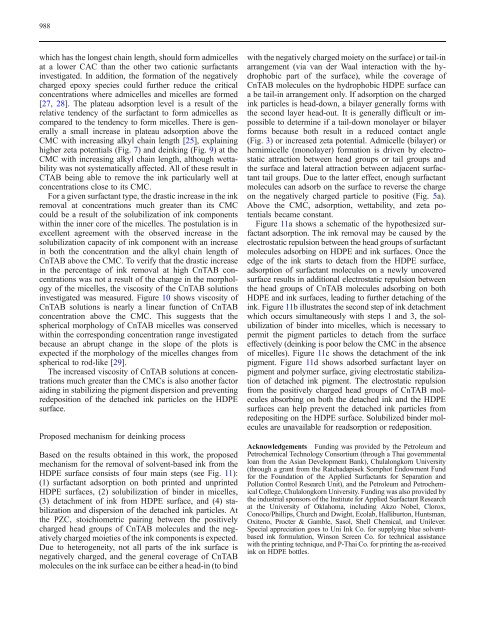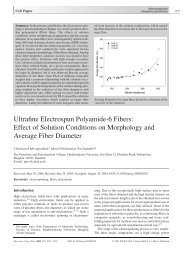Removal of solvent-based ink from printed surface of HDPE bottles ...
Removal of solvent-based ink from printed surface of HDPE bottles ...
Removal of solvent-based ink from printed surface of HDPE bottles ...
Create successful ePaper yourself
Turn your PDF publications into a flip-book with our unique Google optimized e-Paper software.
988<br />
which has the longest chain length, should form admicelles<br />
at a lower CAC than the other two cationic surfactants<br />
investigated. In addition, the formation <strong>of</strong> the negatively<br />
charged epoxy species could further reduce the critical<br />
concentrations where admicelles and micelles are formed<br />
[27, 28]. The plateau adsorption level is a result <strong>of</strong> the<br />
relative tendency <strong>of</strong> the surfactant to form admicelles as<br />
compared to the tendency to form micelles. There is generally<br />
a small increase in plateau adsorption above the<br />
CMC with increasing alkyl chain length [25], explaining<br />
higher zeta potentials (Fig. 7) and de<strong>ink</strong>ing (Fig. 9) at the<br />
CMC with increasing alkyl chain length, although wettability<br />
was not systematically affected. All <strong>of</strong> these result in<br />
CTAB being able to remove the <strong>ink</strong> particularly well at<br />
concentrations close to its CMC.<br />
For a given surfactant type, the drastic increase in the <strong>ink</strong><br />
removal at concentrations much greater than its CMC<br />
could be a result <strong>of</strong> the solubilization <strong>of</strong> <strong>ink</strong> components<br />
within the inner core <strong>of</strong> the micelles. The postulation is in<br />
excellent agreement with the observed increase in the<br />
solubilization capacity <strong>of</strong> <strong>ink</strong> component with an increase<br />
in both the concentration and the alkyl chain length <strong>of</strong><br />
CnTAB above the CMC. To verify that the drastic increase<br />
in the percentage <strong>of</strong> <strong>ink</strong> removal at high CnTAB concentrations<br />
was not a result <strong>of</strong> the change in the morphology<br />
<strong>of</strong> the micelles, the viscosity <strong>of</strong> the CnTAB solutions<br />
investigated was measured. Figure 10 shows viscosity <strong>of</strong><br />
CnTAB solutions is nearly a linear function <strong>of</strong> CnTAB<br />
concentration above the CMC. This suggests that the<br />
spherical morphology <strong>of</strong> CnTAB micelles was conserved<br />
within the corresponding concentration range investigated<br />
because an abrupt change in the slope <strong>of</strong> the plots is<br />
expected if the morphology <strong>of</strong> the micelles changes <strong>from</strong><br />
spherical to rod-like [29].<br />
The increased viscosity <strong>of</strong> CnTAB solutions at concentrations<br />
much greater than the CMCs is also another factor<br />
aiding in stabilizing the pigment dispersion and preventing<br />
redeposition <strong>of</strong> the detached <strong>ink</strong> particles on the <strong>HDPE</strong><br />
<strong>surface</strong>.<br />
Proposed mechanism for de<strong>ink</strong>ing process<br />
Based on the results obtained in this work, the proposed<br />
mechanism for the removal <strong>of</strong> <strong>solvent</strong>-<strong>based</strong> <strong>ink</strong> <strong>from</strong> the<br />
<strong>HDPE</strong> <strong>surface</strong> consists <strong>of</strong> four main steps (see Fig. 11):<br />
(1) surfactant adsorption on both <strong>printed</strong> and un<strong>printed</strong><br />
<strong>HDPE</strong> <strong>surface</strong>s, (2) solubilization <strong>of</strong> binder in micelles,<br />
(3) detachment <strong>of</strong> <strong>ink</strong> <strong>from</strong> <strong>HDPE</strong> <strong>surface</strong>, and (4) stabilization<br />
and dispersion <strong>of</strong> the detached <strong>ink</strong> particles. At<br />
the PZC, stoichiometric pairing between the positively<br />
charged head groups <strong>of</strong> CnTAB molecules and the negatively<br />
charged moieties <strong>of</strong> the <strong>ink</strong> components is expected.<br />
Due to heterogeneity, not all parts <strong>of</strong> the <strong>ink</strong> <strong>surface</strong> is<br />
negatively charged, and the general coverage <strong>of</strong> CnTAB<br />
molecules on the <strong>ink</strong> <strong>surface</strong> can be either a head-in (to bind<br />
with the negatively charged moiety on the <strong>surface</strong>) or tail-in<br />
arrangement (via van der Waal interaction with the hydrophobic<br />
part <strong>of</strong> the <strong>surface</strong>), while the coverage <strong>of</strong><br />
CnTAB molecules on the hydrophobic <strong>HDPE</strong> <strong>surface</strong> can<br />
a be tail-in arrangement only. If adsorption on the charged<br />
<strong>ink</strong> particles is head-down, a bilayer generally forms with<br />
the second layer head-out. It is generally difficult or impossible<br />
to determine if a tail-down monolayer or bilayer<br />
forms because both result in a reduced contact angle<br />
(Fig. 3) or increased zeta potential. Admicelle (bilayer) or<br />
hemimicelle (monolayer) formation is driven by electrostatic<br />
attraction between head groups or tail groups and<br />
the <strong>surface</strong> and lateral attraction between adjacent surfactant<br />
tail groups. Due to the latter effect, enough surfactant<br />
molecules can adsorb on the <strong>surface</strong> to reverse the charge<br />
on the negatively charged particle to positive (Fig. 5a).<br />
Above the CMC, adsorption, wettability, and zeta potentials<br />
became constant.<br />
Figure 11a shows a schematic <strong>of</strong> the hypothesized surfactant<br />
adsorption. The <strong>ink</strong> removal may be caused by the<br />
electrostatic repulsion between the head groups <strong>of</strong> surfactant<br />
molecules adsorbing on <strong>HDPE</strong> and <strong>ink</strong> <strong>surface</strong>s. Once the<br />
edge <strong>of</strong> the <strong>ink</strong> starts to detach <strong>from</strong> the <strong>HDPE</strong> <strong>surface</strong>,<br />
adsorption <strong>of</strong> surfactant molecules on a newly uncovered<br />
<strong>surface</strong> results in additional electrostatic repulsion between<br />
the head groups <strong>of</strong> CnTAB molecules adsorbing on both<br />
<strong>HDPE</strong> and <strong>ink</strong> <strong>surface</strong>s, leading to further detaching <strong>of</strong> the<br />
<strong>ink</strong>. Figure 11b illustrates the second step <strong>of</strong> <strong>ink</strong> detachment<br />
which occurs simultaneously with steps 1 and 3, the solubilization<br />
<strong>of</strong> binder into micelles, which is necessary to<br />
permit the pigment particles to detach <strong>from</strong> the <strong>surface</strong><br />
effectively (de<strong>ink</strong>ing is poor below the CMC in the absence<br />
<strong>of</strong> micelles). Figure 11c shows the detachment <strong>of</strong> the <strong>ink</strong><br />
pigment. Figure 11d shows adsorbed surfactant layer on<br />
pigment and polymer <strong>surface</strong>, giving electrostatic stabilization<br />
<strong>of</strong> detached <strong>ink</strong> pigment. The electrostatic repulsion<br />
<strong>from</strong> the positively charged head groups <strong>of</strong> CnTAB molecules<br />
absorbing on both the detached <strong>ink</strong> and the <strong>HDPE</strong><br />
<strong>surface</strong>s can help prevent the detached <strong>ink</strong> particles <strong>from</strong><br />
redepositing on the <strong>HDPE</strong> <strong>surface</strong>. Solubilized binder molecules<br />
are unavailable for readsorption or redeposition.<br />
Acknowledgements Funding was provided by the Petroleum and<br />
Petrochemical Technology Consortium (through a Thai governmental<br />
loan <strong>from</strong> the Asian Development Bank), Chulalongkorn University<br />
(through a grant <strong>from</strong> the Ratchadapisek Somphot Endowment Fund<br />
for the Foundation <strong>of</strong> the Applied Surfactants for Separation and<br />
Pollution Control Research Unit), and the Petroleum and Petrochemical<br />
College, Chulalongkorn University. Funding was also provided by<br />
the industrial sponsors <strong>of</strong> the Institute for Applied Surfactant Research<br />
at the University <strong>of</strong> Oklahoma, including Akzo Nobel, Clorox,<br />
Conoco/Phillips, Church and Dwight, Ecolab, Halliburton, Huntsman,<br />
Oxiteno, Procter & Gamble, Sasol, Shell Chemical, and Unilever.<br />
Special appreciation goes to Uni Ink Co. for supplying blue <strong>solvent</strong><strong>based</strong><br />
<strong>ink</strong> formulation, Winson Screen Co. for technical assistance<br />
with the printing technique, and P-Thai Co. for printing the as-received<br />
<strong>ink</strong>on<strong>HDPE</strong><strong>bottles</strong>.





